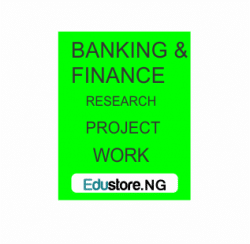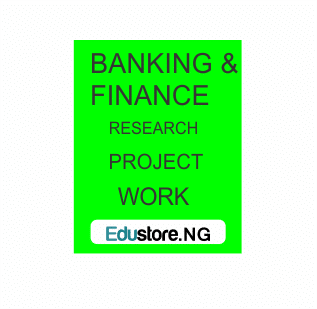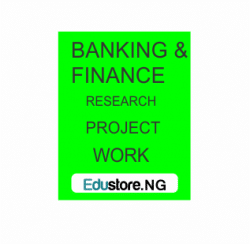The Impact of Capital Structure on the Financial Performance of Financial Institutions in Nigeria From 2009-2023(a Case Study of Aiico Insurance Plc)
INTRODUCTION
Background to the Study
In the ever-evolving landscape of the Nigerian financial sector, the capital structure of financial institutions stands as a critical determinant of their operational capabilities and overall financial health (Modigliani & Miller, 2018). The period from 2009 to 2023 encapsulates significant shifts in the global and domestic economic milieu, including the aftermath of the 2008 financial crisis and subsequent regulatory adjustments (Awunyo-Vitor & Badu, 2022). These events have reshaped the financial landscape, influencing the decision-making processes of financial institutions in Nigeria. In this dynamic environment, understanding the nuances of capital structure becomes paramount for entities seeking resilience and sustainability.
AIICO Insurance PLC, a prominent player in the Nigerian insurance sector, serves as a compelling case study in this context (Awunyo-Vitor & Badu, 2022). The company has navigated through various economic climates and regulatory changes during the specified timeframe, reflecting the adaptability required in the financial sector (Mohammed et al., 2022). The examination of AIICO’s capital structure dynamics and their repercussions on financial performance unveils a microcosmic insight into the workings of this specific entity. By delving into AIICO’s experiences, researchers and industry practitioners can glean valuable lessons that contribute to the broader understanding of the interplay between capital structure and financial performance within the Nigerian financial landscape.
Analyzing AIICO Insurance PLC’s capital structure from 2009 to 2023 offers a retrospective view of the company’s financing choices, shedding light on historical patterns and trends (Basit & Irwan, 2017). The debt-to-equity ratio, a key metric in capital structure analysis, may reveal shifts in the company’s approach to financial leveraging over the years (Awunyo-Vitor & Badu, 2022). Moreover, examining AIICO’s capital structure provides insights into how the company strategically positioned itself to weather economic uncertainties, regulatory changes, and market fluctuations during the studied period (Gujarati, 2021).
The repercussions of AIICO Insurance PLC’s capital structure decisions are intricately tied to its financial performance (Eniola et al., 2017). The evaluation of profitability, liquidity, and solvency metrics over the years offers a comprehensive understanding of the company’s ability to generate returns, meet short-term obligations, and maintain financial stability (Chechet & Olayiwola, 2018). By linking these financial performance indicators to specific capital structure choices, the study can identify correlations, causal relationships, and potential areas for improvement within AIICO’s financial strategy.
The global financial crisis of 2008 marked a turning point for financial institutions worldwide, prompting regulatory adjustments and risk management reforms (Jensen & Meckling, 2018). Understanding how AIICO Insurance PLC adapted its capital structure in response to these challenges becomes crucial in deciphering the company’s resilience and economic adaptability (Dahiru, 2016). The ability to navigate such external shocks underscores the importance of strategic capital structure decisions in ensuring the long-term viability of financial institutions.
Statement of Problem
The dynamic nature of the Nigerian financial sector, coupled with global economic shifts and regulatory changes, has created a complex operational environment for financial institutions (Awunyo-Vitor & Badu, 2022). Against this backdrop, the capital structure decisions of financial entities, including AIICO Insurance PLC, have become increasingly critical. However, the existing literature lacks a comprehensive understanding of how specific capital structure choices impact the financial performance of Nigerian financial institutions, particularly within the timeframe of 2009 to 2023.
The dearth of empirical studies focusing on the nuanced relationship between capital structure and financial performance within the Nigerian context is a significant gap that this research seeks to address. While global studies provide theoretical frameworks (Modigliani & Miller, 2018), the unique challenges and opportunities of the Nigerian financial landscape necessitate a localized investigation. Limited research specifically delves into the experiences of AIICO Insurance PLC, a key player in the Nigerian insurance sector, despite its prominence and resilience in navigating diverse economic climates and regulatory changes (Mohammed et al., 2022).
Moreover, the aftermath of the 2008 financial crisis and subsequent regulatory adjustments have reshaped the financial terrain, making it imperative to assess how financial institutions, including AIICO, adapted their capital structures to ensure sustained financial performance (Jensen & Meckling, 2018). Therefore, the lack of in-depth analysis of AIICO’s capital structure dynamics and their specific impact on financial performance poses a critical research gap. Addressing this gap will not only contribute to the academic understanding of financial management but also provide actionable insights for industry practitioners and policymakers seeking to fortify the Nigerian financial sector against future uncertainties (Gujarati, 2021).
Objectives of the Study
In pursuit of a comprehensive understanding of the subject matter, this study delineates three specific objectives:
- To retrospectively analyze AIICO Insurance PLC’s capital structure from 2009 to 2023.
- To assess the financial performance of AIICO Insurance PLC during the same period.
- To determine the causal relationship between AIICO Insurance PLC’s capital structure and its financial performance over the specified timeframe.
Research Questions
To guide the exploration of the stated objectives, the following research questions will be addressed:
- What are the historical patterns and trends in AIICO Insurance PLC’s capital structure from 2009 to 2023?
- How has the financial performance of AIICO Insurance PLC evolved during the specified period?
- What is the nature of the relationship between AIICO Insurance PLC’s capital structure and its financial performance?
Research Hypotheses
Building upon the research questions, the study formulates the following hypotheses:
Null Hypotheses(H0):
- There is no significant correlation between the capital structure of AIICO Insurance PLC and its financial performance from 2009 to 2023.
- Key determinants of capital structure, such as debt-to-equity ratio and cost of capital, have no substantial impact on the financial performance of AIICO Insurance PLC.
Alternative Hypotheses(H1):
- There is a significant correlation between the capital structure of AIICO Insurance PLC and its financial performance from 2009 to 2023.
- Key determinants of capital structure, such as debt-to-equity ratio and cost of capital, have a substantial impact on the financial performance of AIICO Insurance PLC.
Significance of the Study
This research holds substantial significance across multiple dimensions. Firstly, it makes a noteworthy contribution to the academic domain by conducting a meticulous examination of the intricate relationship between capital structure and financial performance within the confines of a particular Nigerian financial institution. This micro-level analysis adds a layer of depth to the existing literature, providing nuanced insights that have broader implications for similar entities operating within the Nigerian financial sector.
Secondly, the study bears practical importance for a range of stakeholders, encompassing AIICO Insurance PLC, regulatory bodies overseeing the financial sector, and potential investors. The insights gleaned from this research serve as valuable inputs for strategic decision-making within AIICO and comparable financial institutions. These findings are instrumental for refining risk management practices, enhancing operational efficiency, and optimizing capital structures to align with the sector’s unique challenges and opportunities. Additionally, regulatory bodies can leverage these insights to fine-tune existing frameworks, ensuring they remain adaptive and conducive to a resilient financial sector.
Furthermore, potential investors stand to benefit significantly from the outcomes of this study. The detailed analysis of the interplay between capital structure and financial performance in the context of AIICO provides investors with a more informed perspective, aiding them in making prudent investment decisions. By understanding how capital structure dynamics influence the financial health of the institution, investors can assess the risk-return profile more accurately.
In essence, this research transcends the confines of academia, extending its influence into the practical realms of strategic decision-making, regulatory governance, and investment considerations within the Nigerian financial landscape. The outcomes are poised to shape the trajectory of financial institutions, guide regulatory frameworks, and empower investors with a more nuanced understanding of the intricacies associated with capital structure and financial performance.
Scope of the Study
This study focuses exclusively on AIICO Insurance PLC, examining its capital structure and financial performance from 2009 to 2023. The choice of this singular entity allows for a detailed and in-depth analysis, providing specific insights that might be obscured in a broader, more generalized study. The selected timeframe encapsulates critical economic events and regulatory changes that significantly influenced the financial sector in Nigeria.
Operational Definition of Terms
To ensure clarity and precision, the study operationally defines key terms as follows:
Capital Structure: The composition of AIICO Insurance PLC’s financial resources, encompassing the proportion of debt and equity used for financing its operations and investments.
Financial Performance: The overall effectiveness and efficiency of AIICO Insurance PLC, encompassing indicators such as profitability, liquidity, and solvency.
Debt-to-Equity Ratio: A financial metric indicating the proportion of debt used by AIICO Insurance PLC to finance its assets relative to equity; a higher ratio implies greater reliance on debt.
Cost of Capital: The total cost incurred by AIICO Insurance PLC to acquire and utilize capital, encompassing both debt and equity; a crucial factor influencing investment decisions.
Regulatory Framework: The set of rules, policies, and guidelines established by regulatory bodies to govern the operations of AIICO Insurance PLC.
Global Financial Crisis (2008): A severe worldwide economic crisis that occurred as a result of the collapse of major financial institutions and had a profound impact on global economies.
Economic Resilience: AIICO Insurance PLC’s ability to withstand and recover from external shocks, such as economic downturns or financial crises.
Sustainable Development: AIICO Insurance PLC’s commitment to economic development that meets the needs of the present without compromising the ability of future generations to meet their own needs, ensuring long-term viability and balance.
REFERENCES
Uremadu, O, S., & Onyekachi, O. (2018). Impact of capital structure on corporate performance in Nigeria with special focus on the consumer goods firm sector of the economy. Current Investigation on Agricultural Research., 7(3), 2–18.
Velnampy, T., & Niresh, J, A. (2022). The relationship between capital structure and profitability. Global Journal of Management and Business Research, 13(12), 66–74.
Yahaya, O, A. (2022). Corporate social responsibility and financial performance: Evidence from Nigeria. International Journal of Accounting and Finance Review, 10(1), 107–117. https://doi.org/10.1142/S1094406022500
Yahaya, O, A., Farouk, B, K, U., Lamidi, Y, S., Yusuf, M, J., & Dania, I, S. (2021). Impact of competition on the financial performance of listed deposit money banks in Nigeria. Journal of Economics and Sustainable Development, 6(13), 52–61.
Yin, R. K. (2018). Case Study Research and Applications: Designs and Methods (6th ed.). Sage Publications.
DOWNLOAD COMPLETE WORK- For Reference Only: Materials are for research, citation, and idea generation purposes and not for submission as your original final year project work.
- Avoid Plagiarism: Do not copy or submit this content as your own project. Doing so may result in academic consequences.
- Use as a Framework: This complete project research material should guide the development of your own final year project work.
- Academic Access: This platform is designed to reduce the stress of visiting school libraries by providing easy access to research materials.
- Institutional Support: Tertiary institutions encourage the review of previous academic works such as journals and theses.
- Open Education: The site is maintained through paid subscriptions to continue offering open access educational resources.





